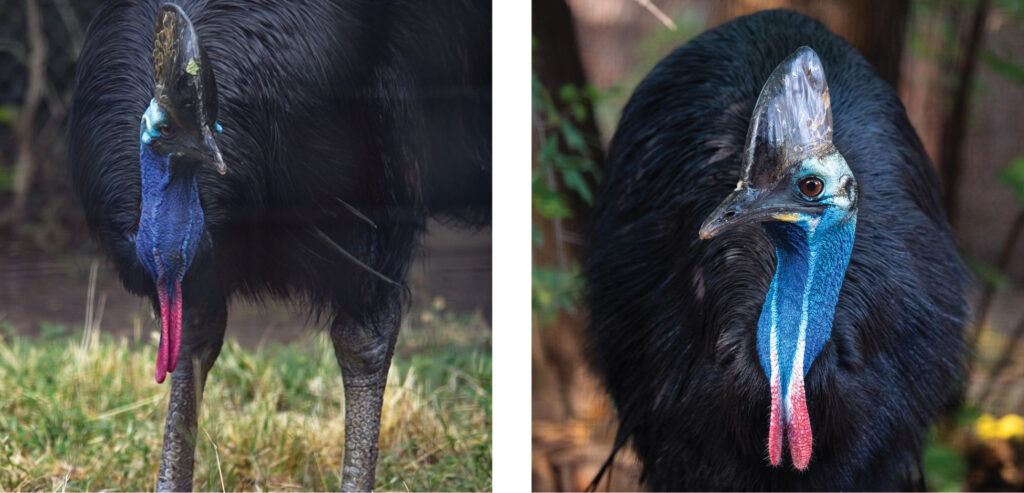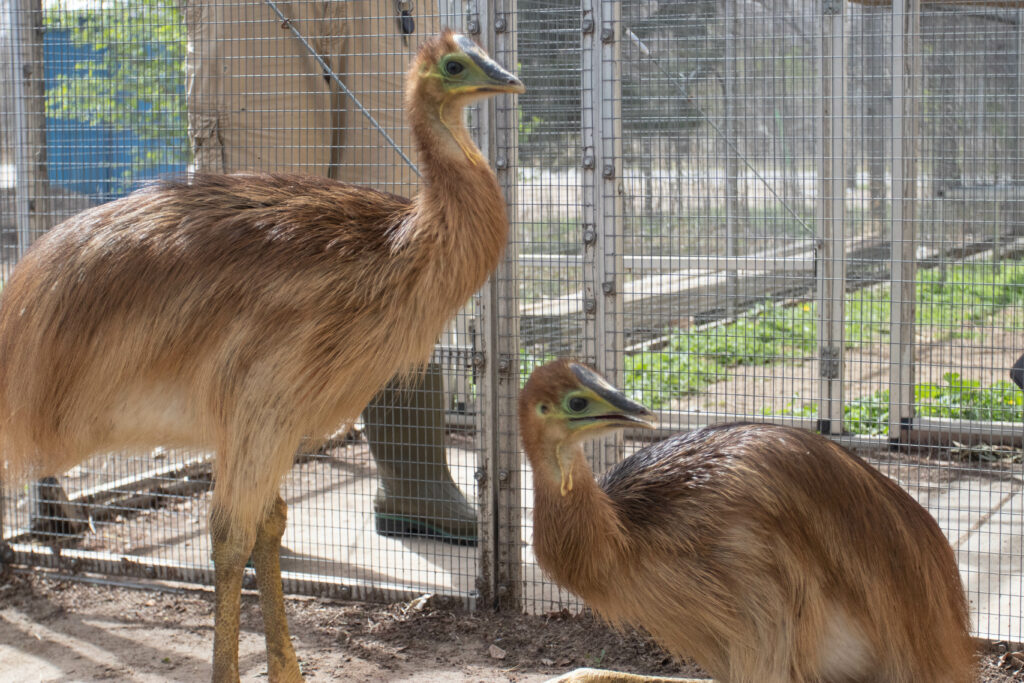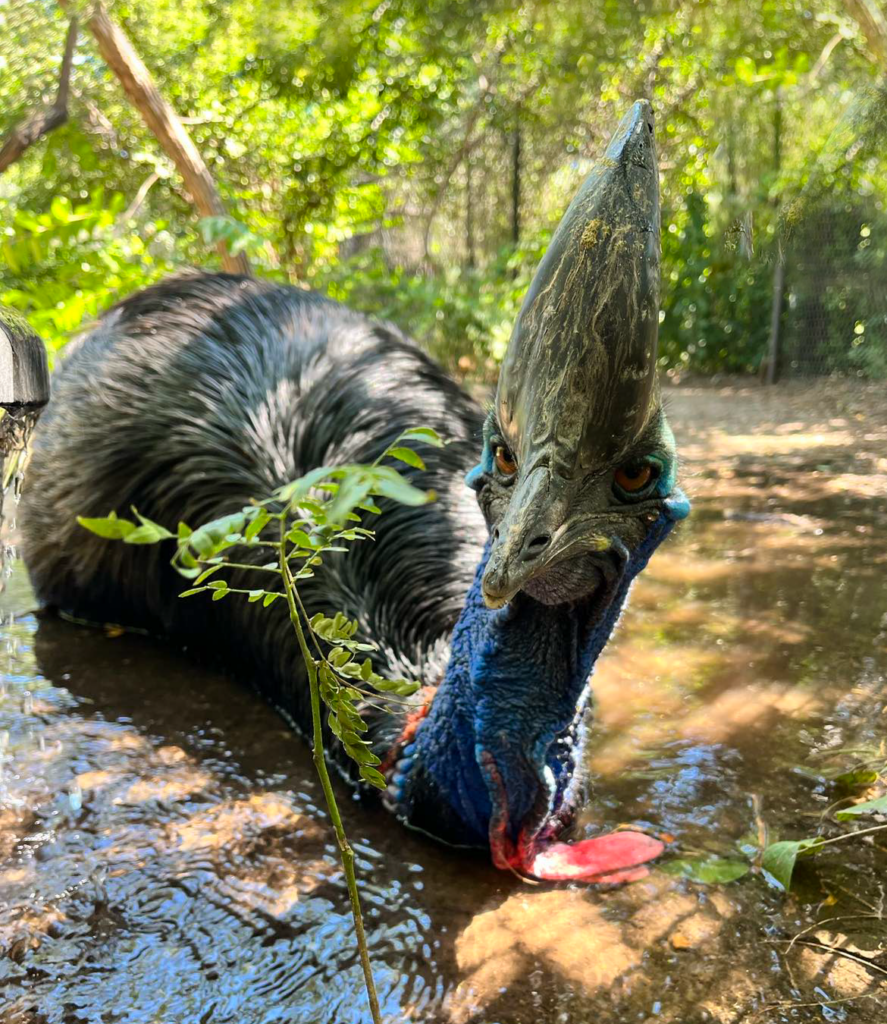Looking into a heavily foliaged habitat, you notice movement in the brush. Next you hear a low, booming call. And then you see it- the animal that calls this habitat home. More than six feet tall, incredibly fast, and equipped with sharp toe claws that measure 5 inches long.
It sounds like an encounter out of Jurassic Park, but you can experience this by visiting the cassowaries at SCZ.
“Cassowaries, and ratites in general, are considered pretty close living relatives of certain avian dinosaurs,” Zoological Manager Ana Frace said.
Cassowaries are ratites- meaning they’re in the same Order as other flightless birds like the ostrich or emu. SCZ has southern cassowaries, which in the wild can be found in the rainforests of Australia and Papua New Guinea.
Cassowaries are a keystone species, which means they play a critical role in maintaining their ecosystem.
“Ecologically, they are incredibly important for their habitat,” Frace said. “They are a primary seed disperser for approximately 240 different species of fruits that they eat.”

Sedgwick County Zoo is home to two southern cassowaries- Bindi and Tully. Both of whom are seven and came to SCZ as juveniles.
“Bindi is our larger bird- females are larger than males,” Frace said. “She loves her grapes. And she can get impatient if you don’t give her her grapes fast enough. She’s also a little more neophobic and more standoffish; she just wants to do her own thing.”
Tully, on the other hand, is by no means people shy.
“He’s the one that a lot of people will say like, ‘oh this bird was at the fence with me.’ That’s probably Tully,” Frace said. “Tully likes to people-watch. All of the people are his fans.”
While their personalities differ, they both agree that nothing hits the spot on a hot day like a bath.
“They love baths,” Frace said. “We turn the mister on and get a good puddle in the mud going and it is their favorite thing.”
Cassowaries are solitary by nature, so Bindi and Tully are never in the same yard at the same time. Like cassowaries in the wild, they only cross paths during mating season. In 2021, Bindi and Tully produced two chicks- Berlari and Lembu. These males now reside at other zoos.

In Australia, federal and Queensland state legislation have declared southern cassowaries endangered.
Like many animals, they suffer population decreases due to habitat loss and fragmentation. Human-animal conflict is the main cause of population decreases. Commercial building is particularly impactful in hurting the cassowary population.
Cassowaries are also frequently hit by cars. Increasing signage and educating drivers helps lessen this threat. Wild dogs are another threat to cassowaries, especially chicks.
“Their natural habitat has shrunk significantly,” Frace said. “Cassowaries become isolated from each other, so that bottlenecks genetics as well.”
Organizations like Rainforest Rescue, which Sedgwick County Zoo supports financially and in the field, work to raise awareness on issues affecting rainforests across the global South. By lobbying policymakers to prioritize conservation and sharing transparent data, real change is being made to save rainforests.
Cassowaries are also culturally important to Aboriginal peoples of Australia. They play significant roles in traditional stories, ceremonies, and dances, but are also appreciated for their role in dispersing seeds and maintaining the tropical rainforests.

“Cassowaries are my favorite species of all time,” Frace said. “For a species that isn’t considered nearly as intelligent as something like a corvid or a parrot, they have such personality.”
Ratites tend to get characterized as unintelligent; we’ve all heard that an ostrich’s eye is bigger than its brain. But Frace says that ratites are smart in their own way, and cassowaries are very intelligent birds.
Cassowaries are also physically distinct. With bright blue faces and necks with red accents, they’re easy to identify. They also sport a casque atop their head, the purpose of which is not fully known.
“There is debate as to what the purpose of that casque is,” Frace said. “The most recent theory, based on a study that was done a couple years ago, is that it actually acts as heat dispersal.”
Other theories of the casque’s purpose on cassowaries range from aiding in call amplification to assisting in pushing brush out of the way when moving through the forest.
“I really love just how prehistoric they are. I mean birds in general- yeah, they’re dinosaurs. But cassowaries just have something extra to them,” Frace said. “That’s my dangerous species that I really enjoy working with.”
While science isn’t quite advanced enough to let you come face to face with a velociraptor or oviraptor, when visiting SCZ, you can meet one of their relatives. At the Australia habitat you might see Bindi foraging for fruit, or Tully people-watching. But no matter what the cassowaries are doing, you’re in for a unique encounter with these big birds.